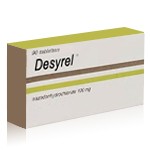Living Through Major Depressive Disorder


Depression has become one of the most discussed health issues of the modern era, yet it is often misunderstood. Beyond feelings of sadness or discouragement that people experience in daily life, there exists a severe clinical form known as major depressive disorder (MDD). This condition affects mood, thoughts, behavior, and even physical health. It is recognized worldwide as one of the leading causes of disability, and its consequences ripple through families, workplaces, and societies. To understand the depth of this condition, one must look at its definition, the variety of symptoms it causes, the impact on everyday living, and the strategies for treatment — including the role of medications such as Desyrel (trazodone).
Understanding the Nature of Major Depressive Disorder
Major depressive disorder is a psychiatric condition marked by persistent low mood and a loss of interest in activities that previously brought pleasure. Unlike temporary sadness triggered by life events, MDD lasts for weeks or months and often recurs throughout life. Its origins are multifaceted: biological changes in brain chemistry, genetic vulnerability, chronic stress, and environmental triggers all play a role. Researchers have identified imbalances in neurotransmitters such as serotonin, dopamine, and norepinephrine, which regulate mood, sleep, and cognition. When these systems malfunction, the result is not only emotional suffering but also impairment in social and occupational functioning.
The condition is not simply an “emotional weakness” or a state someone can “snap out of.” It is a diagnosable medical illness with clear criteria outlined in psychiatric manuals like the DSM-5. Recognizing this distinction is critical for reducing stigma and encouraging people to seek help.
Symptoms That Define the Disorder
Clinicians diagnose major depressive disorder based on the presence of characteristic symptoms that persist most of the day, nearly every day, for at least two weeks. Among the most prominent are a depressed mood and diminished interest or pleasure in almost all activities. These two “core” features are essential for diagnosis, but depression is far more complex than that.
Patients often struggle with changes in sleep, either insomnia where falling or staying asleep is difficult, or hypersomnia where excessive sleeping becomes common. Alterations in appetite and weight can also occur — some people lose their desire to eat and shed pounds, while others find themselves overeating, often turning to comfort foods. Fatigue and loss of energy is another hallmark, making even routine tasks such as bathing or preparing a meal feel monumental.
Feelings of worthlessness or excessive guilt are psychologically crippling, pushing people to focus obsessively on perceived failures or shortcomings. Difficulty concentrating or making decisions reflects the cognitive toll of depression, sometimes resembling early dementia in its severity. More alarmingly, recurrent thoughts of death or suicide may arise, ranging from passive wishes not to wake up in the morning to active planning of self-harm.
The disorder is also described using symptom clusters. Many experts summarize it in eight primary features: depressed mood, loss of interest, changes in appetite, changes in sleep, psychomotor agitation or retardation (visible slowing or restlessness), fatigue, impaired concentration, and suicidal ideation. These eight form the most recognized portrait of major depressive disorder, though their intensity varies between individuals.
Another clinical perspective identifies five core symptoms necessary for understanding the disorder: persistent sadness, loss of interest in normal activities, sleep disturbances, appetite disturbances, and difficulty concentrating. While these five do not encompass every possible manifestation, they emphasize the pillars of what makes depression so disabling in everyday life.
Living With Major Depressive Disorder
Life with major depressive disorder is an ongoing challenge, as it affects not only the inner world of emotions but also relationships, work, and physical health. Many patients describe waking up with a heavy sense of dread, struggling to find motivation even for small tasks. Work performance may suffer because concentration wanes and energy fades quickly. Students often report a decline in grades or the inability to complete assignments.
Socially, individuals may withdraw, avoiding friends or family gatherings. This isolation can reinforce feelings of loneliness, creating a vicious cycle that deepens the illness. Intimacy and family life also become strained; partners may misinterpret the detachment as rejection, while children may feel neglected.
Physical health is another dimension. Depression has been linked to increased risk of cardiovascular disease, weakened immune response, and chronic pain. Stress hormones like cortisol remain elevated, disrupting sleep, metabolism, and overall resilience. As a result, MDD is not only a mental illness but a condition with systemic consequences.
Despite these difficulties, many people do find ways to live with depression through structured support. Therapy provides coping strategies to manage negative thoughts, while social support systems — friends, family, or peer groups — remind individuals they are not alone. Lifestyle changes such as regular exercise, consistent sleep patterns, and mindful nutrition can complement medical treatment. Living with MDD requires adapting to its unpredictable waves but also learning that remission is possible with the right tools.
Approaches to Treatment
Because major depressive disorder is complex, its treatment must be multidimensional. Psychotherapy, medication, and lifestyle interventions together offer the greatest chance of relief. Cognitive behavioral therapy (CBT) helps patients identify and reframe distorted thought patterns that feed depression. Interpersonal therapy focuses on repairing strained relationships and communication problems. For severe or treatment-resistant cases, interventions like electroconvulsive therapy (ECT) or transcranial magnetic stimulation (TMS) may be considered.
Pharmacological treatment plays a pivotal role for many patients. The aim is to restore the balance of neurotransmitters in the brain. Selective serotonin reuptake inhibitors (SSRIs) are often first-line, but other classes such as serotonin-norepinephrine reuptake inhibitors (SNRIs), tricyclic antidepressants, and atypical antidepressants are equally important depending on the case. Among these, Desyrel — better known by its generic name trazodone — holds a particular place.
The Role of Desyrel in Managing Depression
Desyrel (trazodone) is classified as an atypical antidepressant. Unlike SSRIs that primarily boost serotonin, trazodone acts on both serotonin receptors and transporters, producing a dual effect: enhancing serotonin activity while also modulating receptor sensitivity. This mechanism contributes to its antidepressant properties and explains its sedative qualities, which are especially useful for patients whose depression is accompanied by severe insomnia.
Many individuals with major depressive disorder suffer from disrupted sleep, often waking in the early hours of the morning with racing thoughts. By prescribing Desyrel, physicians can address both depression and insomnia simultaneously. Its calming effect helps restore healthier sleep cycles, which in turn improves mood regulation and energy levels.
Desyrel is generally well tolerated, though some patients may experience side effects such as drowsiness, dizziness, or dry mouth. Unlike older tricyclic antidepressants, it carries a lower risk of weight gain or sexual dysfunction, making it a suitable alternative for certain patients. Importantly, it should always be prescribed and monitored by a healthcare professional, as misuse or abrupt discontinuation can cause complications.
The medication is often used in combination with therapy and sometimes with other antidepressants to maximize results. In modern clinical practice, it serves as both a primary treatment for depression and an adjunctive therapy when other antidepressants alone are insufficient.
The Human Experience of Recovery
Recovery from major depressive disorder is rarely linear. Patients often experience partial improvements followed by relapses. The goal of treatment is not only symptom reduction but also restoration of functioning — the ability to enjoy relationships, work productively, and participate in life’s activities. Even when remission is achieved, ongoing management may be necessary to prevent recurrence.
People who live with depression describe recovery as a process of learning self-awareness. Recognizing early warning signs, such as sleep disruption or increased irritability, allows them to seek help before a full depressive episode develops. Supportive environments — workplaces that understand mental health, families that encourage treatment, communities that reduce stigma — make a tangible difference in outcomes.
Medications like Desyrel provide stability, but it is the combination of medical care, therapy, and personal coping strategies that creates resilience. For some, creative outlets like writing, painting, or music serve as emotional release. Others find strength in mindfulness, yoga, or spirituality. What unites these approaches is the recognition that depression is not simply eradicated but managed through sustained effort and support.
Conclusion
Major depressive disorder is a profound medical condition that reshapes how people think, feel, and live. Defined by persistent sadness, lack of pleasure, fatigue, and cognitive difficulties, it affects millions worldwide and contributes to immense personal and societal costs. Understanding the eight key symptoms and the five central ones provides clarity in diagnosis, while recognizing the human struggle of living with the condition deepens empathy.
Treatment is possible, and many achieve meaningful recovery. Therapies and medications, especially agents like Desyrel that target both mood and sleep, play a vital role in restoring balance. The journey with major depressive disorder may be long and unpredictable, but with knowledge, compassion, and comprehensive care, individuals can reclaim quality of life and look toward the future with renewed hope.
Drug Description Sources: U.S. National Library of Medicine, Drugs.com, WebMD, Mayo Clinic, RxList.
Reviewed and Referenced By:
Dr. Alan Carter, PharmD Clinical pharmacist specializing in psychopharmacology and chronic conditions. Frequently cited on Drugs.com for reviewing therapeutic guidance on trazodone, antidepressants, and their pharmacokinetics, dosage, and safety profile.
Dr. Carol DerSarkissian, MD Board-certified in internal medicine, contributor to WebMD. Her clinical reviews focus on mood disorders, including major depressive disorder and anxiety, with expert insights on antidepressant treatment strategies.
Dr. Dianne B. McKay, MD Professor of Clinical Pharmacology, contributor to RxList and NIH publications. Her medical insights address the long-term safety, side effects, and systemic implications of antidepressant therapies like trazodone.
Dr. William C. Shiel Jr., MD, FACP, FACR Chief Editor at MedicineNet and affiliated with WebMD. Authored comprehensive medical content on depression, antidepressant mechanisms of action, and evidence-based psychiatric treatment options.
(Updated at Sep 29 / 2025)

